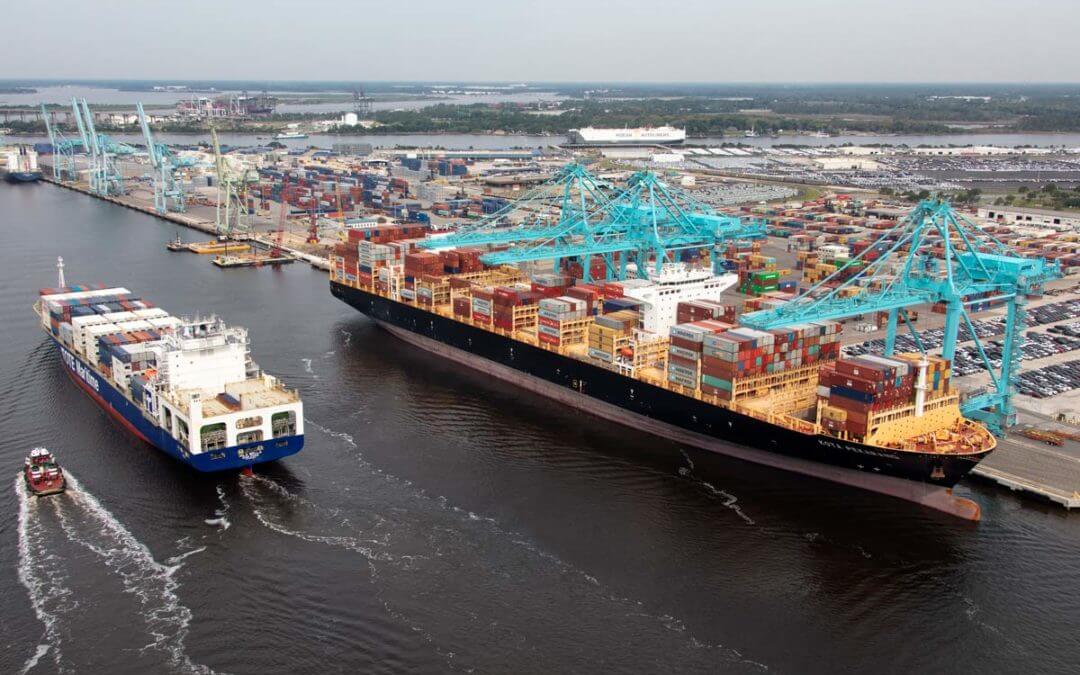Florida’s growth spurs increased need for transportation services (Courtesy of the Jacksonville Business Journal) — Cruises, hotels and winter homes have long been a cash cow for Florida, but as more people flock to the sunshine state for more permanent stays, the transportation and logistics industry is capitalizing on the need for cargo.
Ports and distribution centers are seeing explosive growth alongside the Sunshine State’s population boom, as businesses invest in a growing body of consumers and workers.
New infrastructure to increase the capacity is attracting a slew of new businesses to the state, from the deepening of the St. Johns River in Jacksonville opening the door to bigger boats to the growth of the I-4 Logistics Park in Central Florida allowing for more distribution throughout the region.
Nearshoring reemergence
As companies are still navigating a freight recession and encountering increased costs from geopolitical issues such as war surcharges and tariffs, some see a solution by investing in nearshoring and expanding shipping connections outside of longtime manufacturing heavyweight China.
Florida’s proximity to the Caribbean Sea, Central America and Mexico make it a hot zone of increasing interest in nearshoring.
But closeness to other countries and nations is only part of the picture.
Jacksonville-based maritime company Crowley runs a sophisticated system to invest in infrastructure and technology to ensure frequency of service, capitalizing on nearshoring and helping the company keep up with global shipping giants.
Brett Bennett, Senior Vice President and General Manager at Crowley, said domestic and international investments are key to Crowley’s success.
As the bulk of Crowley’s business goes through the Caribbean and Central America to countries such as Honduras and El Salvador, ships often used Crowley’s terminal at Port Everglades in BrowardCounty.
But the company is capitalizing on rail access and more port capacity on its home turf in Jacksonville. In 2022, Crowley began calling ships to Jaxport.
“When you think about an overall transit time point of view, how we compete with the globals is frequency of service, meaning we got multiple sailings a week, whether it be in and out of the Dominican Republic, in and out of Central America, whatever it may be and speed, we have smaller ships with fewer ports of call,” said “So the globals may have a ship that’s three times as big as ours, they may have to stop at three times as many ports in order to fill it up. For us, it’s back and forth, right, and that speed … when you think about the apparel industry, we really become part of their manufacturing process by bringing cotton or other rolled goods south to Central America, bringing finished goods north for a good, balanced trade.”
Jacksonville’s on-dock rail connection that Crowley started using in 2021, allows for service into Charlotte, Atlanta and Chicago, and brings great connection time and options for customers, Bennett said.
“So for us, Jacksonville benefits from there’s only so much that’s going to be able to fit through Port Everglades and through Miami as a whole,” Bennett said. “And our customers are finding we’re seeing customers open up operations, warehouse(s) and other things in Jacksonville as well. So I think you’ll continue to see Jacksonville positioned well for growth, particularly as Savannah continues to fill up. And maybe (as) some of the East,West trades need a relief valve.”
As Jacksonville becomes a new gateway for nearshoring, other areas of Florida are seeing massive investment in distribution centers.
But many areas face challenges in finding labor and building up utilities for increased energyneeds.
Warehousing boom fuels labor worries
Demand for distribution centers in South Florida exploded since the pandemic as out-of-state wealthy families and businesses set roots in the tri-county area.
While there are signs that the market is off its peak highs, the warehouse sector is as strong as the region’s economy, said Lauren Pace, senior vice president of Colliers South Florida.
“A lot of our success comes from population increases and unemployment is still extremely low. The combination has helped the industrial market very well here,” Pace said.
Still, Frank Trelles, executive managing director of Vivo Real Estate Group, said companies have become increasingly uneasy about closing on leases due to uncertainty over the economy.
“They’ve been hearing the word recession, and that’s a scary word,” Trelles said.
Justin Ruby, a partner with Orlando-based Foundry Commercial agrees.
“As the state continues to experience an in-migration of a healthy, vibrant and resourceful population, there is continued demand for well-located industrial outdoor storage properties as well as transportations hubs for distribution,” Ruby said. “We’re forecasting a continued focus on infill locations, with the primary growth happening along the infrastructure corridors that connect cities to the primary thoroughfares.”
Companies in the market for distribution buildings are now looking for facilities with taller ceiling heights.
“If you look at most industrial buildings built 10 years ago, they were 24-foot clear height. Then they jumped to 28 feet and 32 feet. And in the last year they were 36 feet,” said Michael Moore, director of business development for brokerage TCRE. “Now we have a few that are pushing forward with a 40-foot height.”
Indeed, the taller the ceiling, the less square footage you need in a distribution building.
“By taking a smaller space, they’re reducing their monetary expenditures, but they still have the same, if not greater storage,” Trelles said.
The taller ceiling heights are the result of technological advances in stacking machines, HVAC systems, tracking, and forklifts that now demand distribution buildings with taller ceiling heights, Trelles added.
Going forward, the greatest challenge for the distribution sector is labor, said Colliers’ Pace.
“The cost of living is pretty high, and you have to have someone working who makes well over minimum wage,” she said. Yet even then, Pace said, “it’s hard to retain good labor.”
Moore said economic development groups such as the Beacon Council, the Greater Fort Lauderdale Alliance, and the Business Development Board of Palm Beach County can do more to create programs that can provide a reliable workforce for distribution facilities.
“We need more blue-collar skilled workers who know how to operate stacking machines and forklift operators,” he said.
Adapting to change
City Furniture’s new 1.3 million square foot distribution facility and showroom in Plant City will play a pivotal role in the company’s strategic expansion throughout the state.
Andrew Koenig, president of City Furniture, said they have plans to open multiple showrooms throughout Tampa Bay in the next two years, which will be supplied via the Plant City center.
“I think the pandemic sped up some trends, especially with consumers wanting their products faster,” Koenig said. “I don’t think anything is going backwards.”
Finding real estate for warehouses is increasingly difficult as the I-4 corridor and its surrounding neighborhoods fill out. Some of the larger concerns, however, are “more upstream,” according to Koenig. Supply chain issues — both domestically and globally — have caused significant delays.
As a response, many distribution facilities are storing greater quantities of goods so delays don’t impact their customers, which requires more space. Instead of a “just in time” motto, companies now operate under a “just in case” mindset. Especially for essentials like medical supplies.
Mark Levy, president of BBX Logistics Properties, said since the pandemic they have seen an “extraordinary amount of leasing demand” that exceeded what anyone could have envisioned. In the past 18 months, they have returned to a leasing demand level similar to 2019.
Levy said 2020 to 2023 was an abnormality that was “frankly unsustainable.” The continued net migration into Florida will keep the interest in launching new facilities along the I-4 corridor steady. However, the tenant makeup hassignificantly changed.
During the pandemic large national tenants with requirements for substantial warehouse space were racing into markets across the country. Many large spec facilities were built as developers were confident they’d be leased. Post-Covid, the large tenants “hit the brakes,” and Levy said now, thanks to inflation and interest rates, there’s a continued pause on national companies’ expansion plans.
“The opposite effect is happening with smaller tenants,” Levy said. “In the pandemic, nobody was building products to fit these smaller companies, so those tenants had very few options. They were renewing or taking leases in less-than-ideal facilities, and it became a landlord’smarket in that regard.”
Levy said that historically, the company’s “sweet spot” has been leases under 100,000 square feet. BBX is building a 213,000-square-foot facility on I-4 and SR 33 in Lakeland, which they can use to accommodate multiple smaller tenants.
Automation has become a key part of their design for new facilities. Power consumption has drastically increased in the past several years, as has the need for larger parking requirements. Tenants want EV charging, LEED-certified buildings, and flexible design.
AI has created a higher level of prediction for supply chain needs. Levy said Amazon created an algorithm to understand customers on multiple levels, perfecting the art of anticipating their buying habits and having goods stocked at last-mile facilities that would be most frequently ordered. Other companies, Levy said, are replicating that model.
“My business is harder than it’s ever been in terms of finding sites and developing new projects,” Levy said. “It takes 18 to 24 months to get a project through the entitlement process, and it can take three years before you introduce a new project into the market. You have to constantly be anticipating new trends at least three years out. If you wait for a trend to emerge, you’re too late.”

